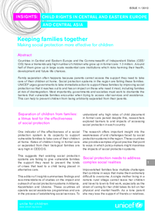This edition of Insights produced by UNICEF summarizes the findings and recommendations of studies on the impact and outreach of social protection systems in Albania, Kazakhstan, and Ukraine. All three countries operate social assistance programmes for children and families and are in the process of establishing social services, but high rates of child placement in formal care still persist, indicating that existing social protection systems are failing to give vulnerable families the support they need to prevent the kinds of crises that lead to a child being placed in alternative care.
The studies found that low-income families, particularly those in remote rural areas or caring for a disabled child, are at highest risk of family separation. Residential care continues to be the main way states attempt to meet the needs of disabled children. Although a small number of 1-5% of the child population, disabled children represent 50% of the residential care population. Young families with babies often struggle to cope with the expenses of caring for a new child. As a result, a large number of 0-3 year olds are taken into institutional care. Single mother, families with a parent dependent on drugs or alcohol, ethnic-minority Roma families in Albania, and migrant families with no fixed addresses in Kazakhstan are also identified as high-risk groups.
An overall appraisal of the social protection systems in the three countries found that they have established clear legislative frameworks for developing comprehensive social protection systems, but families are still not receiving effective support because targeted social assistance programs intended to alleviate poverty are not reaching the majority of needy households and because non-institution based social services are only being accessed by a small number of parents and caregivers due to lack of information and effective service delivery mechanism. The authors identify a range of reasons for this, including lack of awareness about eligibility for assistance, applications for means-tested social assistance are too complicated, a lack of transparency and fairness about access to social assistance, parents, staff and decision-makers often lack knowledge about social services, centre-based social services are usually in towns and difficult for vulnerable families to reach, while weak outreach of the available support leads to low-take up by those who need it most.
Some of the interesting solutions being developed in those countries to address some of these barriers are highlighted and the authors make comprehensive recommendations relevant to many of the countries in the CEE/CIS region. In particular, they point out that better impact can be achieved at low cost by better coordinating and integrating existing social protection interventions. In practice this means: Using the existing infrastructure and reach of social assistance, health and education structures to extend the reach of social services. Ensuring that there is a nationally agreed minimum package of social protection services and social assistance for all who need it, regardless of where they live in the country and what vulnerabilities they face.
©Insights Issue 1/2012, UNICEF

